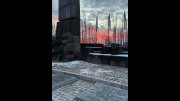As Harvard’s president, Lawrence S. Bacow spoke upon occasion about his mother, Ruth Wertheim—the only Jewish resident transported from her hometown of Londorf, Germany, to Auschwitz who survived the Nazi concentration camps. He also explained why he had never been able to bring himself to visit one of the camps—until this past January, after the University asked him to be its representative at the ceremony observing the eightieth anniversary of the liberation of Auschwitz and Birkenau on January 27, 1945. He agreed and traveled to Poland with his wife, Adele Fleet Bacow. Hearing survivors speak at the ceremony, he recalled, reminded him that, “As Elie Wiesel once said, ‘The opposite of love is not hate. It is indifference.’ The world right now cannot afford indifference.”
At Harvard Magazine’s request, he wrote about what he saw and felt, an account published online on February 5, titled “The World Right Now Cannot Afford Indifference.” This excerpt describes the Bacows’ private tour of the site two days before the formal observance. His complete essay appears at harvardmag.com/bacow-auschwitz-25. —The Editors
EVEN THOUGH my mother had described her time at Auschwitz in some detail, Adele and I were still unprepared for what we saw.
Auschwitz is immense. Upon entering, one encounters barracks almost as far as the eye can see, flimsy wooden structures with dirt floors, in many cases former stables. Here, my mother and tens of thousands of other prisoners were housed with little food, less heat, and only a latrine for sanitary facilities. Despite attempts by the Nazis to destroy them completely before the end of the war, the remnants of the gas chambers and crematoria are also still visible. The Nazis designed Auschwitz for only one purpose: to murder people as quickly and efficiently as possible. To put the scale of the place in context, 2,977 people died on 9/11. By contrast, more than one million Jews were murdered in Auschwitz.
In 1944, my mother and her family were jammed into a cattle car with others from Theresienstadt for the trip to Auschwitz. With no food or water available, many did not survive the trip. Those who did emerged onto a large platform. A Nazi officer separated those who could work from those who could not, the sturdy from the frail, the young from the old. Since most prisoners were already emaciated from detention in other concentration camps, about 80 percent of those who were transported to Auschwitz were sent immediately to the gas chambers.
As Adele and I stood on the same platform, the gas chambers and crematoria were visible to us just as they had been to my mother and all other deportees arriving at Auschwitz. We recalled her description of being separated from her parents, the heartbreak of knowing that she would never see them again. If you closed your eyes, you could imagine the desperation: the cries of the families being separated, the smoke rising from the crematoria, and the stench of burning flesh that my mother said constantly hung over the camp. I kept thinking not only of my mother who survived, but those who did not, especially the young children who immediately went to their deaths upon arrival—all 250,000 of them...
Our tour of Auschwitz ended with a visit to the Book of Names, where the six million victims of the Holocaust are recorded. I searched and found the names of my family: my grandfather, Leopold Wertheim, for whom I am named; my grandmother, Emma Wertheim; and my aunt, Ingeborg Wertheim. Like all of the six million, they have no graves, they have no headstones, but they are not forgotten. They are in the Book of Names.








